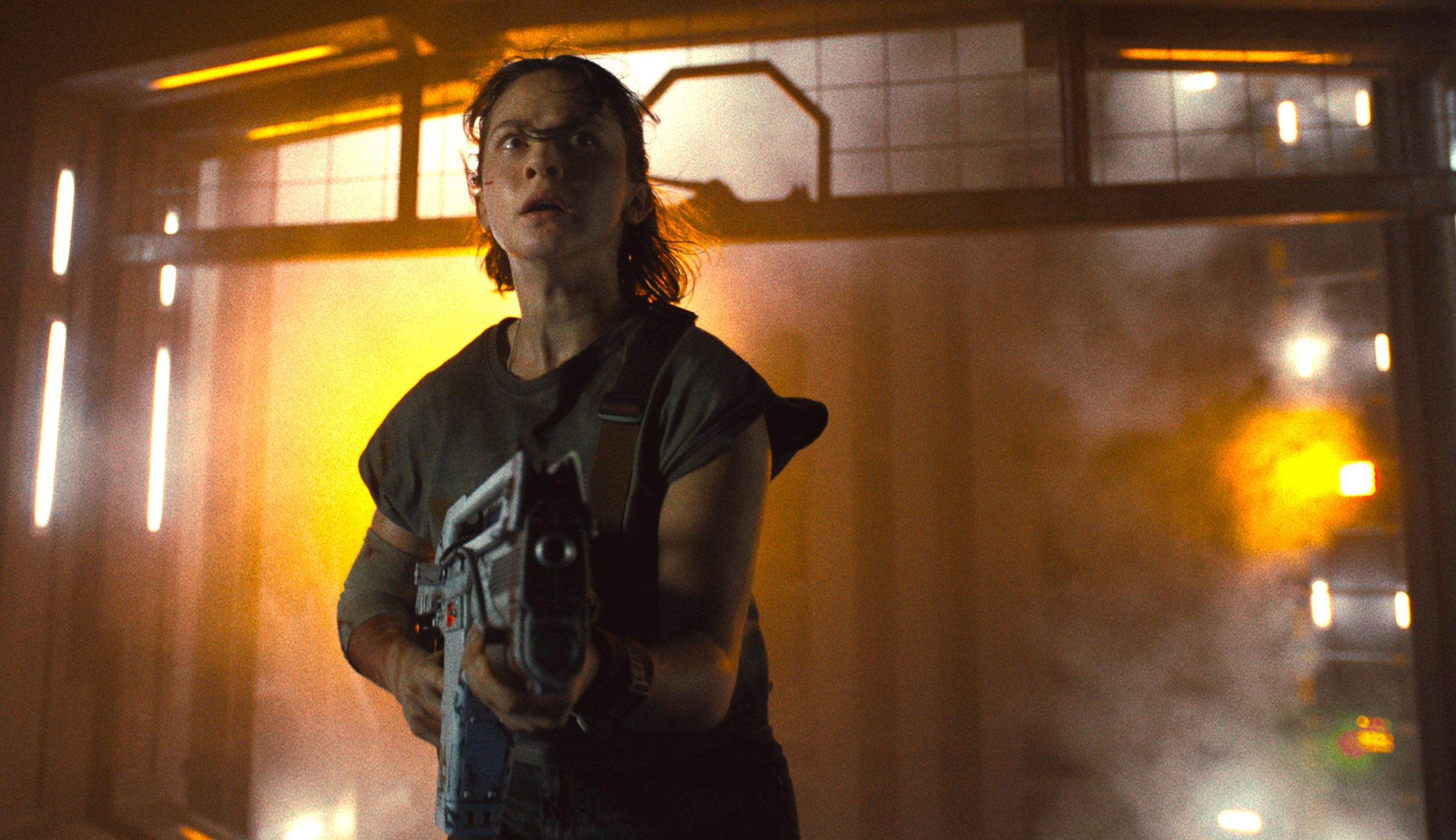
This article contains spoilers aplenty for Alien: Romulus and the whole franchise.
“I admire its purity,” a robot says during an infamous scene in Alien. Ian Holm’s synthetic science officer is of course referring to the “organism” (or “xenomorph” as Aliens later defines it). However, this line of dialogue has gone on to be cherished by science fiction fans all over the world as a metaphor for the original, sleek, and mysterious 1979 movie that started it all.
It would seem director Fede Alvarez and his Alien: Romulus co-writer Rodo Sayagues would agree. Their new seventh entry in the mainline Alien franchise is a love letter to nearly everything that came before. (Like us, they seem to generally exclude Alien vs. Predator whenever possible for matters of taste and decency.) That is definitely seems to be the case with the many callbacks, homages, and easter eggs to the original Ridley Scott film. However, Alien: Romulus also includes nods, winks, and allusions to every other proper film in the series… and even one fairly underrated video game. So without further ado, let’s dig into the many easter eggs and references in Alien: Romulus!
Alien
While Alvarez and the stars of Alien: Romulus have made it clear the sequel is largely a synthesization of the two most beloved films in the series, Scott’s 1979 classic and James Cameron’s audacious 1986 sequel, it seems safe to surmise Alvarez and company lean closer in affection to the first film. This at least seems likely after watching the very opening of the Romulus.
In addition to composer Benjamin Wallfisch reprising the opening motifs of Jerry Goldsmith’s eerie and lonely musical score from Alien, Romulus’ titles sequence echo both the credits of Alien and its subsequent scenes. We begin with a quiet, desolate shot of the stars in space before watching a human-piloted vessel move through the darkness. The titles then continue over a more urgent but familiar collection of shots of an autopiloted ship coming awake.
Shortly afterward, we realize that we are not only watching a scene echoing Alien, but which is directly following up on it, with this Weyland-Yutani spaceship recovering what appears to be the frozen ruins of a chunk of the Nostromo, the self-destructed vessel from the first movie. The white coats also appear to have recovered the remains of the xenomorph of that film who was last seen floating through endless space after Sigourney Weaver blew it out of “the goddamn airlock.” It must’ve attached itself to some Nostromo remnants and built a nest inside.
This sets the tone for the myriad easter eggs to Alien. Some are bemusingly silly, such as the “bird drinking water” toy we saw mindlessly twirling during the opening shots of the Nostromo waking to life in 1979 (it also has appeared in various other movies, including Alien: Covenant). Here it enjoys breakfast alongside Cailee Spaeny’s Rain and David Jonsson’s android Andy. Other references, however, are far more foreboding, such as Andy and other members of Romulus’ collection of fleshy humans entering the Renaissance Space Station through the menacing, hissing round air vents that invited Tom Skerrit’s Captain Dallas to his doom in Alien. Come to think of it, none of the human characters who enter the space station that way fare much better in Romulus.
One of these blokes, Bjorn (Spike Fearn), also discovers the makeshift electrical cattle prod Harry Dean Stanton’s Brett put together to catch the chestburster in that movie. We at last see how well it works against a facehugger (effective!) and a full-grown xenomorph (makes it only bleed a little acid, much to Bjorn’s regret.) In the same scene of the movie, Tyler (Archie Renaux) uses the heat sensor Dallas and company attempted to track the xenomorph down with.
Alien: Romulus also calls back to the death of Brett later in the film when Kay (Isabela Merced) sees the docking bay of the Remus side of the Renaissance space station be doused with sprinkler water that somehow looks like hot rain that will never cool you off. In this shower, she resembles Brett who also faced a xenomorph in such a lonely locale before being whisked to a mysterious fate.
Yet the biggest callback that, in fact, turns into a supporting character is the return of Ash—or at least his android model. Dubbed Rook in this movie (which in itself is an Aliens reference detailed below), this uncanny valley recreation of the late great Ian Holm’s 45-year-old performance comes complete with needless callbacks to Ash’s many quotable lines: “it’s the perfect organism;” “I can’t lie about your chances… but you have my sympathies.”
However, beyond the copious fan service, what’s most interesting about Ash/Rook’s inclusion is how he rewrites the series and leans it in the favor of Alien over Aliens (as well as Prometheus). By that we mean Ash suggests this “perfect organism” is incredibly intelligent and formidable, and not merely a “bug.” This is alluded to, as well, when Andy (under Rook’s influence) tells Rain and Tyler that the creature is “laying a trap” by baiting them to open the door to save Kay.
This ties into Ash’s original admiration of the creature, as well as Alien’s suggestion that it can reproduce without need of an Alien Queen. We never see a Queen onboard the Romulus, but it seems many of the people who got disappeared on the space station, and later Kay, were made prey for reproduction. This is what went down with Dallas in the “director’s cut” of Alien too. Meanwhile Brett’s fate is clarified when a xenomorph obliterates Tyler’s face after taking him into the air. For food or fun, we’re never sure.
Just as importantly, Rook reveals that Weyland-Yutani has been searching for “the xenomorph” since reports of a vessel were destroyed 20 years ago. This is obviously a reference to the fate of the Nostromo and suggests Ash/Mother (the automatic computer and brain hive of the Nostromo) broadcast secret reports back to Earth. We also learn the Renaissance has a “Mother” central computer that Rook communicates with, and which shows him the infamous “PURGE” graphic from Alien and Blade Runner when it’s “game over” at the end of the movie.
Finally, the entire climax of Alien: Romulus is more or less a retread of the ending of Alien where Weaver’s Ripley blows the xenomorph out of the airlock. The creature is different and instead of an airlock, our new heroine Rain uses the acid blood associated with the xenomorph to eat part of the hull of her ship. However, the sequence begins with Rain in her underwear ready to take the long sleep, only to be left vulnerable and exposed to a surprise alien threat. She ultimately is able to get a space suit on, kill the creature, and even leave a perhaps unnecessary officer’s log relaying that she is the last human survivor of this very bad and no good day. In other words, the end of Alien but bigger.
Prometheus (and Alien: Covenant)
While Alien: Romulus doesn’t lean as heavily on the other films in the series, it is still able to tie all the movies together, and one of the most surprising reference points is Prometheus. This also begins with Rook’s plentiful exposition.
Rook hits the nail on the head when he says that this alien creature is something they have been searching for since receiving the “Prometheus files.” Rook is obviously referring to the Prometheus mission from the 2012 movie of the same name, which was undertaken to feed the vanity of one man, the Company’s founder Peter Weyland. Rook further states that while Peter died looking for immortality, the scientists aboard the Renaissance Space Station cracked the code. The Company has been searching for this creature ever since the Prometheus expedition’s failure, and they actively sought out the ejected xenomorph from the Nostromo.
This is game-changer stuff, confirming what fans have long speculated in regards to Alien: The Company knew what was on LV-426, or at the very least had programmed Ash/Mother with their prime directives in case a crew ever picked up a signal that would bring the Company into contact with alien life similar the stuff found on LV-223 (although we never learn why they just didn’t return to that moon, which was said to have multiple derelict Engineer ships).
Rook furthermore reveals that the Company doesn’t want the organism as a bio-weapon; they wish to reverse engineer its creation in order to find the “Prometheus strain” that could give Homo sapiens immortality—Weyland’s dying wish, as it is for every old man. But viewers should recognize Rook’s prized sample is actually some form of the black goo in Prometheus, which turned several scientists into monsters, and after several rapidly gestating generations, produced a version of the xenomorph inside an Engineer’s belly.
So it is that when Romulus’ Kay uses the black goo in the hopes of saving her life and the life of her unborn child, she instead transforms her baby into a monstrous abomination. It becomes a hybrid of a human, a xenomorph, and an Engineer from Prometheus—and technically Alien: Covenant as well. This creature is birthed out of her in a violent grotesque way, similar to the C-section/abortion scene in Prometheus. All of which suggests Weyland-Yutani is still meddling in forces beyond our understanding, and which was forbidden by our creators. The results are a bastardization of the face of “god” (an Engineer) being mixed with the demonic horror of the xenomorph.
Aliens
While Alien: Romulus definitely favors the Ridley Scott films, there is still a lot of love and perhaps over-homage to arguably the most popular film in the series, James Cameron’s Aliens. This stems from the very beginning of the movie, with the film being set on Jackson’s Star, which is apparently a mining colony reminiscent of Hadley’s Hope in Aliens (the space colony overrun by xenomorphs in that film).
When we spoke with Alvarez for Den of Geek magazine, he said he got the idea of the film from watching the deleted scene from Aliens where little kids rode big wheels around the colony. What would have happened if they had been allowed to grow up? “It would have been hard to live in a colony where there’s no future,” the director said. “You’re either a farmer or a miner, and that’s all you can be, and it’s going to take 50 years for the atmosphere to be ready. Human beings, we’re not cut out for that.”
We also get confirmation about a line that this writer always found curious in Aliens: “They mostly come out at night. Mostly.” Was there ever much daylight on LV-426? At least on Jackson’s Star, the answer is a resounding no since a digital signal informs us there are zero hours of daylight throughout the year.
The film includes other subtler nods, such as Rook being discovered cut in half at the waist, just like the android Bishop’s fate in Aliens. Furthermore, the name “Rook” is obviously a reference to the game of Chess, much as Bishop’s was in the ‘86 movie.
Romulus also evokes several iconic set pieces in Aliens. The scene of facehuggers attempting to jump Bjorn and Tyler—before sadly getting a foothold inside of Navarro (Aileen Wu)—faintly resembles the sequence of facehuggers attempting to impregnate Ripley and Carrie Henn’s Newt. However, it is mostly during the third act of Romulus that the Aliens influences become overt. Our heroic Rain and Tyler obviously get their hands on some prototypes of the pulse rifle Ripley and the Colonial Marines toted in Aliens (Andy even gives the marines a name drop). As seen in the trailer, Rain eventually is rocking that bad boy like Ripley in the third act of Aliens where there is inexplicably wind inside of closed corridors (the ‘80s!).
But also the exact setup of the ending, with the Romulus half of the space station being covered in a kind of webbing or alien gunk alludes to the nests the xenomorphs built in Aliens (as does their name of “xenomorph” finally being used again). During the best action sequence of the movie, Rain has to do it like Ripley and watch her ammo. The film might even slightly one-up Aliens and the other sequels in another regard: the xenomorph’s acid blood becomes a major concern, right down to it eating through the hull of the space station after the xenos are injured—a la the original Alien.
The Romulus space station’s elevator greatly resembles the elevator in the power station of Aliens, and Andy gets the tacky chance to needlessly quote the famous Ripley line from Aliens: “Get away from her… you bitch.”
Also it turns out that like the Colonial Marines, the space colonists on Jackson’s Star love themselves some Reeboks.
Alien Resurrection
While it clearly ties into the mad science of Prometheus and Alien: Covenant, the hybrid monster Kay births at the end of Romulus also visibly echoes the infamous Newborn creature Ellen Ripley’s clone gives birth to in 1997’s Alien Resurrection. Like the strangely more cuddly, yet still grotesque, Newborn, the Xenogineer in Romulus seems to briefly entertain some childlike affection toward Kay, its biological mother. However, perhaps the intense aggression of the Engineer species (or the xenomorph?) leads it to kill mama before going classic movie monster on Rain.
Alien 3
Perhaps the least homaged or referenced of the other Alien movies, David Fincher’s controversial and debated Alien 3 is at least visually winked at when the xenomorph who briefly saves Rain’s life in the elevator shaft then tries to crawl atop of her for the most intimate of attacks. The shot composition of the mouth-within-a-mouth reaching out for Rain deliberately echoes the most famous shot of a xenomorph getting within inches of Ripley’s face before letting her live because she’s already impregnated with a chestburster.
Alien: Isolation
In perhaps the most surprising and pleasant of easter eggs, Alien: Romulus also tips its hat to the wildly underrated video game, Alien: Isolation. Like Romulus, this game is set in the more than 50-year gap between the first two movies. And in that context, players got to take control of Ripley’s daughter, Amanda Ripley, who also finds herself trapped on a space station—albeit the game’s airport-sized Sevastopol is run by a sloppy competitor of Weyland-Yutani (which is saying something).
Like the Sevastopol, Romulus’ Renaissance Space Station has frequent old school-looking communication boxes—or glorified telephone booths. For anyone who played Alien: Isolation, these booths should trigger instant anxiety since they represented both salvation and the most awful of deaths. They are that game’s save points, but even as you’re in the process of saving your progress, you can be attacked and eaten alive by the Alien if you’re in the midst of being hunted and making too much noise.
The game seems visually referenced as well during early shots of sunlight, and later illumination caused by the Corbelan IV flying near the open windows of the Renaissance. These brief moments emulate the fleeting instances of bright yet cold orange sunlight being gleaned outside the Sevastopol. It’s an ’80s color palette befitting Blade Runner. The Renaissance also seems to connect its two halves, Romulus and Remus, by horizontal trains similar to those in the video game.
There are all the references and eggs we caught after a first viewing! Did we miss anything? Let us know in the comments below!
The post Alien: Romulus’ Biggest, Grossest, and Strangest Easter Eggs from the Other Movies appeared first on Den of Geek.





